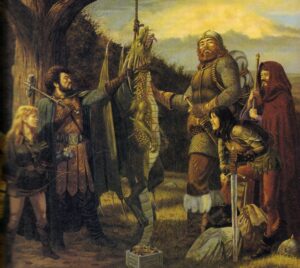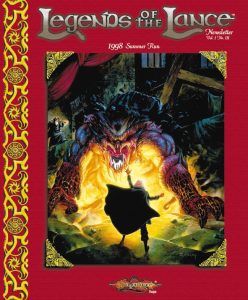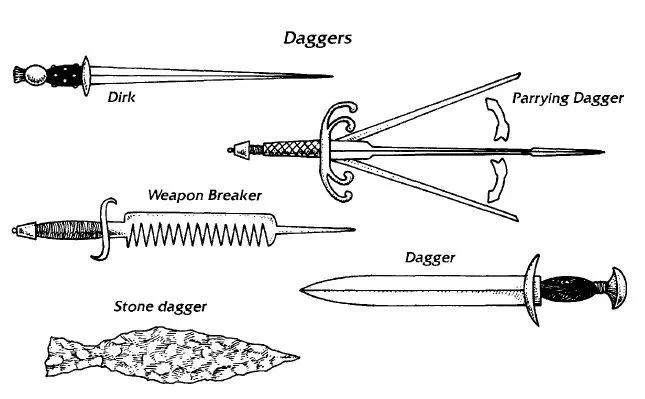
When traveling, adventuring, you will find yourself in dangerous places. Weapons like the dagger, flail and lance are great choices to protect yourself and your party, else your treasures. But having a weapon and being proficient in its use are very different. So, knowing about each of these weapons is a must for any wielder. This knowledge could save our character's life. But it may also give you some insight, so you know your enemy.
Dagger

The typical dagger has a pointed, usually double-edged blade, as opposed to a knife, which has a single edge and is a bit shorter than the dagger. The dagger is one of man's oldest weapons. The first daggers were most likely hand-held spearheads used by cavemen, made of bone or stone.
Bone daggers are made from the bones of large animals such as reindeer and bison, with one end sharpened and the handle carved to resemble the animal from which the bones came. Such daggers are relatively fragile, and stone replaced bone when early man discovered how to work with stone.
Stone daggers are more difficult to make due to the composition of stone. Most stone daggers are made of flint, a hard stone that can be worked easily. The flint is chipped until the proper shape is achieved, usually that of a broad leaf, then it is sometimes lashed to a wooden handle. This sort of stone dagger has a major weak point: the place where the blade is attached to the handle.
Primitive tribes know that the best stone dagger is made from a single piece of stone with the dagger's handle consisting of a straight section of stone. The handle is then wrapped in hide for a good grip. The average stone dagger measures 12 inches long. When man began working with copper and bronze, the technique of making a dagger's handle and blade from a single piece of material remained.
Blade lengths increased up to 24 inches long, and when the length exceeded this, a new weapon, the short sword, was born. Some weaponsmiths have turned dagger making into an art form, decorating the handles, cross guards, and even the blades, with beautiful carvings. Some daggers are decorated with carved scenes derived from a culture's mythology.
With the advent of swords, the dagger was relegated to the role of back-up weapon. In fact, the average Roman soldier did not carry a dagger, but his Teutonic barbarian enemy used them. As the barbarian's influence swept over Europe, the dagger was given new life. Daggers with steel blades became necessary in order to penetrate armor. Although knights carried daggers, they were considered a weapon of last resort.
The modern handshake derives from a habit used by bodyguards. They would take the hand of anyone visiting the king and shake his arm, hoping to dislodge any dagger concealed in the visitor's sleeve.
"A dagger is great because it's easy to conceal, it's good in close-fighting or as a backup weapon, and it's shape allows it to be hurled. It has only a few problems-it's a short weapon, with neither the reach nor the damage potential of a sword.
A dagger makes a handy tool as well. Soldiers and adventurers use their daggers as eating utensils. Owning a sharp blade that is easily carried makes life easier (just try drawing a long sword to cut some bread or a piece of rope!).
My favorite advantage of a dagger is that when you rely on stealth, you can use a dagger to dispatch a foe and draw less attention than resorting to a sword, in which case you might as well yell out your intentions. This is one reason why those of us who attack our enemies indirectly savor the dagger and usually carry at least two."
Jasmine, Halfling Thief
Dirk Dagger

A dirk has qualities of both the dagger and the knife. While useful as a weapon, it was designed for a variety of uses. It is a version of the ballock knife (or "kidney dagger"). The dirk has two round, symmetrical globes at the base of the handle, where the handle meets the blade. The grip itself emerges from between the globes and is flared at the top. The blade is often made from a large shard of a sword blade.
The dirk is a single-edged, grooved weapon with a back edge near the point. It usually features a decorative notch at the base. Most dirks have a special scabbard that has two small pockets in the front, one for a knife and one for a fork, used by warriors in the field as an early mess kit.
The dirk is a Scottish weapon, carried by Highlanders, making its appearance in the late 17th century. The grip is usually leather, ivy root, or ivory. In the 18th century, the dirk was sometimes mounted in silver or gold. Though normally considered a civilian weapon, the dirk was produced as a military blade when Scottish men were incorporated into Britain's regular army.
Parrying Dagger

This specialized type of dagger is used in conjunction with a sword. It is used to catch or break an opponent's sword. Some versions of this dagger are equipped with spring blades that split into three blades at the push of a button. When such a dagger is employed in this fashion, it cannot be thrown successfully.
Most parrying daggers have long, straight or curved quillons, and a tough side ring that extends perpendicular to the blade in order to protect the user's fingers.
Unlike the main-gauche, the parrying dagger is made for a specific purpose, to deflect or break an opponent's weapon. The maingauche, while also good for parrying, is less of a weapon-breaker.
Dart
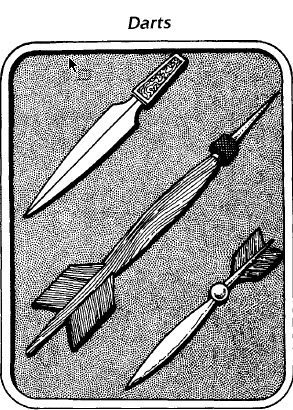
The dart is a small, easily concealable missile weapon that is thrown rather than fired from a bow or other launcher. Darts are known to exist among advanced caveman tribes. These darts are usually small, wooden shafts fitted with a head of bone or stone.
In modern cultures, darts have leaf or arrow- shaped heads and stabilizers on the shaft's butt end, much like miniature arrows. Many cultures use darts for sport, hunting, and warfare on land and sea. Lizard men use barbed darts.
"Darts are small, easy to hide, and have a good rate of fire. Range is slightly better than a dagger, but darts cause less damage. Darts may be smeared with various toxins to make them more effective. It makes sense to fire darts at their maximum rate (three per round), which not only gives the thrower three changes of hitting, but also offsets the low damage potential by offering the possibility of multiple hits.
A dart is a good weapon to throw at a spellcaster. As long as one dart hits a spellcaster, the latter's spell is ruined, regardless of the damage caused. Of course, this is why many spellcasters carry darts. Most are nimble enough to use them effectively, and if Gaff 70 •Chapter Three they are unable to cast a spell but see an enemy spellcaster about to cast, a dart can ruin the spell. It helps to be a sharp-eyed, quick-thinking, nimble, handsome fellow such as myself."
Malraz Alizar the Magnificent, Illusionist
Flail
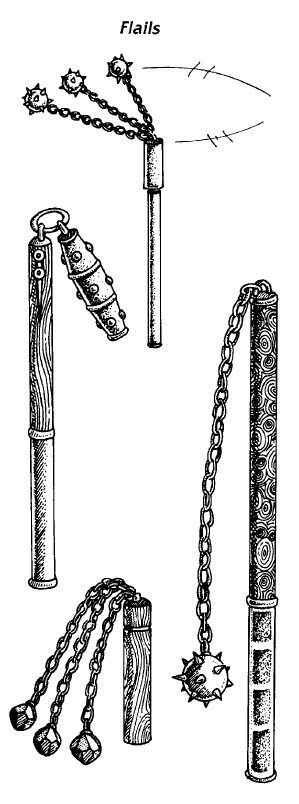
The flail is a sturdy wooden handle attached to an iron rod, a wooden rod with spikes, or a spiked iron ball. Between the handle and its implement is either a hinge or chain link. The weapon was originally used as a tool for threshing grain. Whether a flail is used by a foot soldier or a horseman, the principle is the same.
Rumors tell that the Hinds' flindbars are in fact a variation of the flail. This has not been substantiated, and the Hinds have no wish to cooperate in the research.
The footman's flail has a handle approximately four feet in length. It otherwise conforms to the above description.
The horseman's version of the flail has a two-foot-long handle. The horseman already has a good positional advantage, sitting atop a horse, and consequently does not need the greater reach afforded by the long handle of the footman's flail. This is a one-handed weapon.
"In the adventurer's world, a flail can be used by warriors or priests, especially if the latter is not allowed edged weapons. The footman's flail causes more damage, since the longer pole enables the wielder to make a stronger swing. This is a good weapon to use in subduing someone, or even for a disarming maneuver. Bear in mind that the footman's flail is a two-handed weapon, whereas the horseman's flail is one-handed.
There is certainly no problem in a footman using a horseman's flail, although it is not a good habit. A foot soldier would be better off with a different blunt weapon that can cause more damage or have more versatility, such as a warhammer."
Brother George, Cleric
The followers of Peter the Hermit who fought in the Crusades in the 11th and 12th centuries used flails, placing spikes on the short flail heads. This adaptation gave rise to other modifications, such as replacing the second bar with two or more iron balls attached by chains.
Footman's flails were used mostly in the 13th and 14th centuries by foot soldiers, especially peasant troops, while the horseman's version enjoyed use by cavalry troops during the same time period.
Flails were used as late as the 1920's by Polish peasants against Soviet troops.
Gaff (also known as a Hook)
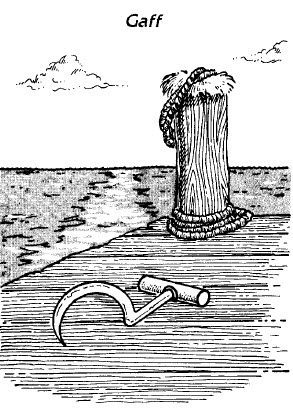
The gaff or hook is actually a tool used to hook and land fish. It is commonly found where fishing boats are encountered, and the hooks are in plentiful supply, affording the disarmed adventurer a weapon of last resort.
The gaff consists of a metal hook with a wooden or metal crossbar at the base. A onehanded tool, the hook protrudes from between the middle and ring fingers.
Some sailors who have lost a hand have a cup with a gaff hook attached to the stump, guaranteeing that they are never without a weapon.
"Ya don't often see adventurers whacking away with gaffs. To them, it's only a tool. But more often than not, dock workers, press gangs, pirates, and sailors have a pretty good swing with those hooks."
Rych the Seeker, Harbormaster
Hand Axe (also known as a Throwing Axe)
The hand axe or throwing axe is also known as a hatchet. The axe blade has a sharp steel tip, counterbalanced by a pointed fluke. The short handle has a point on the bottom and the head may have a spike on top.
This weapon is often used by barbarian tribes. Some hand axes are carried on the saddles of knights and horsemen, who respect this weapon after seeing barbarians wield the axes effectively.
Despite this acceptance by civilized folk, the throwing axe is often relegated to backup weapon status since the creation of the battleaxe, whose longer handle gives the wielder greater force in his swing. The maximum length of the hand axe's handle is about 18 inches, not very great, though better than a dagger's reach in hand-to-hand combat. The throwing axe's last advantage, its ability to be hurled, was eclipsed with the advent of better bows such as the long bow.
Short races such as gnomes make good use of hand axes. The gnomes' traditional enemies, the kobolds, also use hand axes. The weapon's size is small enough to be wielded properly, and it can be hurled as a last resort. Dwarves, of course, are far more interested in the heavier battleaxe.
"The throwing axe is a good backup weapon for an adventurer. It can be used in melee combat or as a missile weapon, although with mediocre range. The weapon is also useful as a general tool, especially to outdoor types such as rangers, who often need a good tool to hack away at undergrowth in order to blaze a trail."
Dalraun lronedge, Ranger
Harpoon
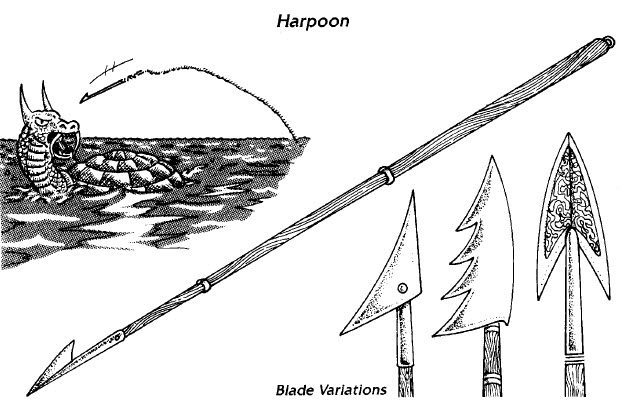
The harpoon is a hunting weapon, which, in times of duress, may be used for defense. Its development by primeval man was for hunting marine mammals and large fish.
The first harpoons were merely pointed sticks. Later, these became sticks with a sharp head of horn or bone. The heads often had hooks cut into them for increased damage and to hold the harpoon fast in the beast's flesh. The head was then fitted or attached to the end of the shaft, secured by animal sinews.
Metal harpoon heads evolved later, most with pointed or barbed heads. These heads are usually detachable from the shaft, but are connected to the thrower by a cord attached between the point and the barb.
When a hunter throws the harpoon and hits an animal, he follows the victim as best he can, playing out as much rope as needed until the beast tires and dies.
Some creatures may be of sufficient intelligence to try to free themselves from the harpoon. If the target has Intelligence of 2 or greater and some means of dislodging the hook or breaking the line, it is allowed a saving throw vs. poison. Success means the victim is freed. Failure means the harpoon is still attached, the victim takes another hit point of damage, and is drawn 10' closer to the harpoon's wielder. The victim is pulled toward the wielder only if a concentrated attempt is made and the victim is of a size and weight that makes this possible (e.g., a harpooned whale cannot be hauled in by a fighter with 13 Strength).
Certain primitive jungle tribes traditionally use harpoons to hunt wild boar. Kuotoa, the aquatic subterranean fish-men, favor the harpoon with as many nasty barbs on the weapon as possible.
Harpoons may be used one or two-handed, and there is no change in speed factor for using it one way or the other. This is a definite advantage. On the other hand, the harpoon has a poor throwing range, and damage potential is less when it is used onehanded, much like a bastard sword. The harpoon is a common weapon in coastal areas, but its primary function is not as a weapon against an intelligent opponent.
Adventurers on ships may experiment with fitting harpoons onto ballista launchers, if the DM permits. This may be especially handy if the character's are hunting some sea creature that they must haul back to port.
Javelin

Javelins are classified as light spears, suitable for melee or missile combat, usable either on horseback or on foot. The weapon has been around since man's earliest days. The javelin head is not very large, and is usually leaf-or lancet-shaped. Javelin heads may have barbs.
As a weapon of war, the javelin has low popularity, though it is often used for hunting purposes. Javelins are also used as aceremonial weapon of bodyguards in civilized nations. Halberdier yeomen are often assigned javelins.
Javelin throwing is a common contest of the games of sport of ancient civilizations. Javelins may be used either one- or twohanded, and like the harpoon, there is no difference in speed factor between the two styles. The javelin has a respectable throwing range, certainly better than that of a spear, with damage potential comparable to the spear. Like the harpoon, the javelin gives the adventurer the advantage of a weapon that may be used effectively either as a melee weapon or as a missile weapon.
Many drow carry javelins, often coating the weapons with the same poison they use on crossbow bolts. Kobolds also use javelins, as any weapon which inflicts damage from a long distance is embraced by that cowardly race. Advanced races of lizard men are also javelin users.
Knife

A knife consists of a single-edged, pointed blade with a handle mounted asymmetrically. It is an early weapon, used even by primitive tribes. In these cultures, a knife is little more than a flint blade with one or two cutting edges.
Bone knives are little more than a sharpened piece of bone, often decorated in the same way as daggers. Like other bone weapons, bone knives are apt to shatter.
True knives appeared when man began using alloys such as bronze. A knife was cast from a single piece of bronze, with a single straight edge or slightly curved blade. The curvature is often accentuated near the point.
When man began using iron, knife handles went through a change. The malleability of iron made it easy to create and keep a sharp edge, while also enabling the maker to extend the blade into a flat tang, which was then covered with sidepieces of wood, bone, or horn. This made the handles easier to decorate. In primitive civilizations, knives are used as an all-purpose tool, on the hunting grounds, and as a tool of sacrifice.
Different forms of knives may be found among the different peoples who depend heavily on this useful tool. Small knives are made for domestic uses, longer knives for hunting and war.
Small knives exhibit their own evolution, resulting in the common man's small knife with a four-inch blade and a plain handle of bone or horn. The more influential citizen may have a knife with a handle of rock crystal or other stone, enclosed in a precious metal. Despite the great value of these knives, they are not as effective in combat as the larger knives ( -1 to attack and damage rolls).
Non-domestic knives, or outdoor knives, have stronger blades and sharper points. They are carried in their own sheaths, or in the scabbard of a larger weapon, such as a sword, creating a specialized set.
In some areas, knife makers are prohibited from selling knives with leaf-shaped blades. Such decrees are an effort to prevent such knives from being carried casually. The leaf shape causes a large, gaping wound that bleeds heavily.
"Though it seems as if a dagger and a knife are very much alike, there are important differences. A knife is lighter than a dagger. Its shape does not allow it to be thrown as easily, which explains why the lighter knife has the same throwing range as a dagger. The knife causes only slightly less damage than the dagger. Both weapons have the same rate of fire. The dagger is less a tool and more a weapon, while it can be argued that the reverse applies to the knife.
An adventurer of high station way wish to have a knife and a sword of similar design, both housed in one scabbard. Such a thing is certainly considered a status symbol (definitely a mixed blessing).
A big advantage of knives is that they are found everywhere. Cooks, trappers, and hunters are but three occupations that justify carrying a knife."
Peripim Furfoot, Halfling Adventurer and Professional Cook
Lance


The term "lance" originally referred to spears wielded by footmen and cavalry. It eventually referred only to cavalry spears.
Lance design varies between cultures and eras. Generally, the lance is a long shaft of tough wood, usually ash, with an iron head in the shape of a laurel or willow leaf, with cutting edges and a sharp point meant to penetrate armor. Lances are meant to be gripped close to the bottom, putting a great distance between the wielder and his target. As a rule, the lance is aimed diagonally above the horse's neck. The opponents face each other with their left sides oncoming.
Along with almost any variety of sword, the lance is considered the best offensive weapon for mounted soldiers. Some knights carry a small fabric pennant affixed just below the lance head. These pennants are either triangular or square, and carry the colors or symbols of the knight's family or liege.
In parades, lances are held vertically, with the butt set in a stirrup or on the horseman's right thigh. On a march, the lance is held across the shoulder, across the saddlebow, or horizontally alongside the horse.
Through evolution, weaponsmiths sought to increase the damage caused by the lance by making them heavier.
One of the biggest problems with using a lance is the jarring impact on the user. In order to address this problem, a thick leather ring called a graper is fitted to the shaft just behind the wielder's hand. This acts as a stop against the armpit, halting the lance's rearward motion upon impact. Another important part of a lance is a rest. The rest is a small, sometimes folding bracket fixed to the right side of the knight's breastplate armor. The graper is leaned against this rest when the lance is in use. The rest enables the knight to get the maximum push from his lance, inflicting the most damage.
The difference between the light, medium, and heavy, lances stems from the length (10' for a light, 12' for a medium, and 14' for a heavy), and weight (five pounds, ten pounds, and fifteen pounds for light, medium, and heavy respectively). Each lance type can be used only if the rider is on a horse of corresponding type or greater. Thus, a knight on a heavy warhorse can use any lance, while the scout on a light warhorse is limited to the light lance.
Jousting Lance
Jousting lances, used in "jousts of peace;' are the heaviest lances, weighing 20 pounds and measuring at least 13 feet long. These lances are fitted with a three-pronged head in order to prevent armor penetration. The prongs are short, blunt projections that emerge from the headpiece, as opposed to a sharp point. This lance is also known as a "courtesy lance:' In a full tilt, a joust of war, the head is blunt and may actually cause fatalities.
Locathah riding on the backs of giant eels use light lances.
"Light lances can be used as a polearm by adventurers who do not relish combat on horseback, preferring instead to meet the enemy on foot. It can be hard to wield a heavy lance in a forest, so a medium lance may be a good compromise.
Lances are best used as a mounted weapon. When used from the back of a charging mount, it inflicts double damage.
Nothing is more awe-inspiring than a mounted knight, wielding her lance and charging a dragon. Of such things legends are made, and no mounted warrior worth his salt should be without his lance, especially a paladin. I know I have mine!"
Maura Smallwood, Paladin
Use these weapons to Party Up and Slay That Ancient Dragon




